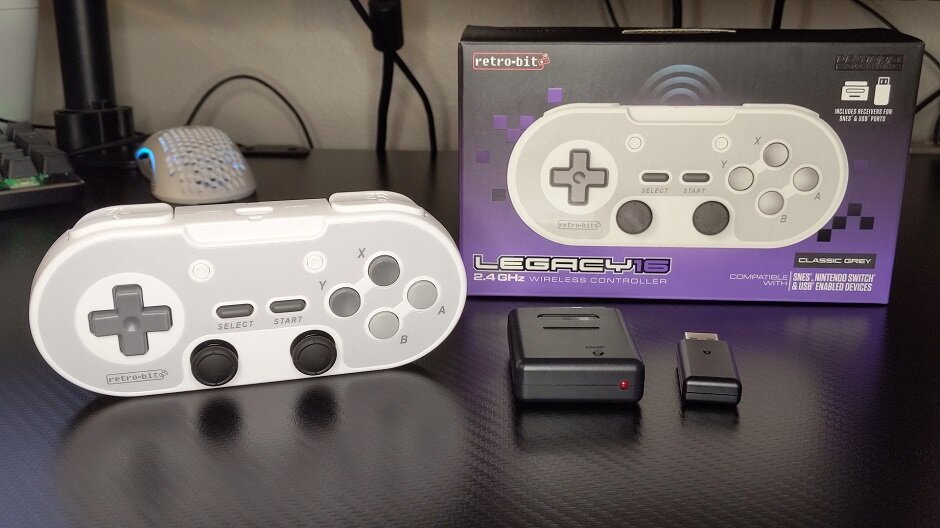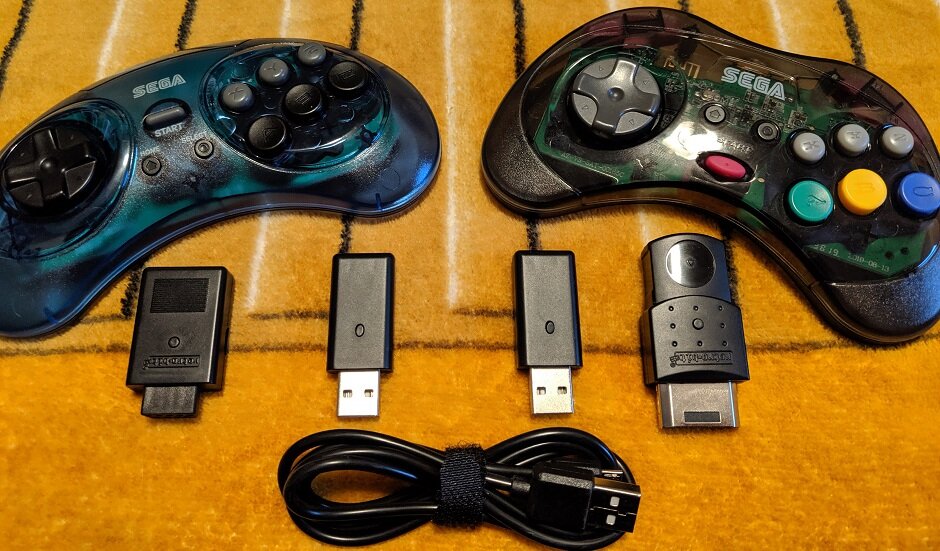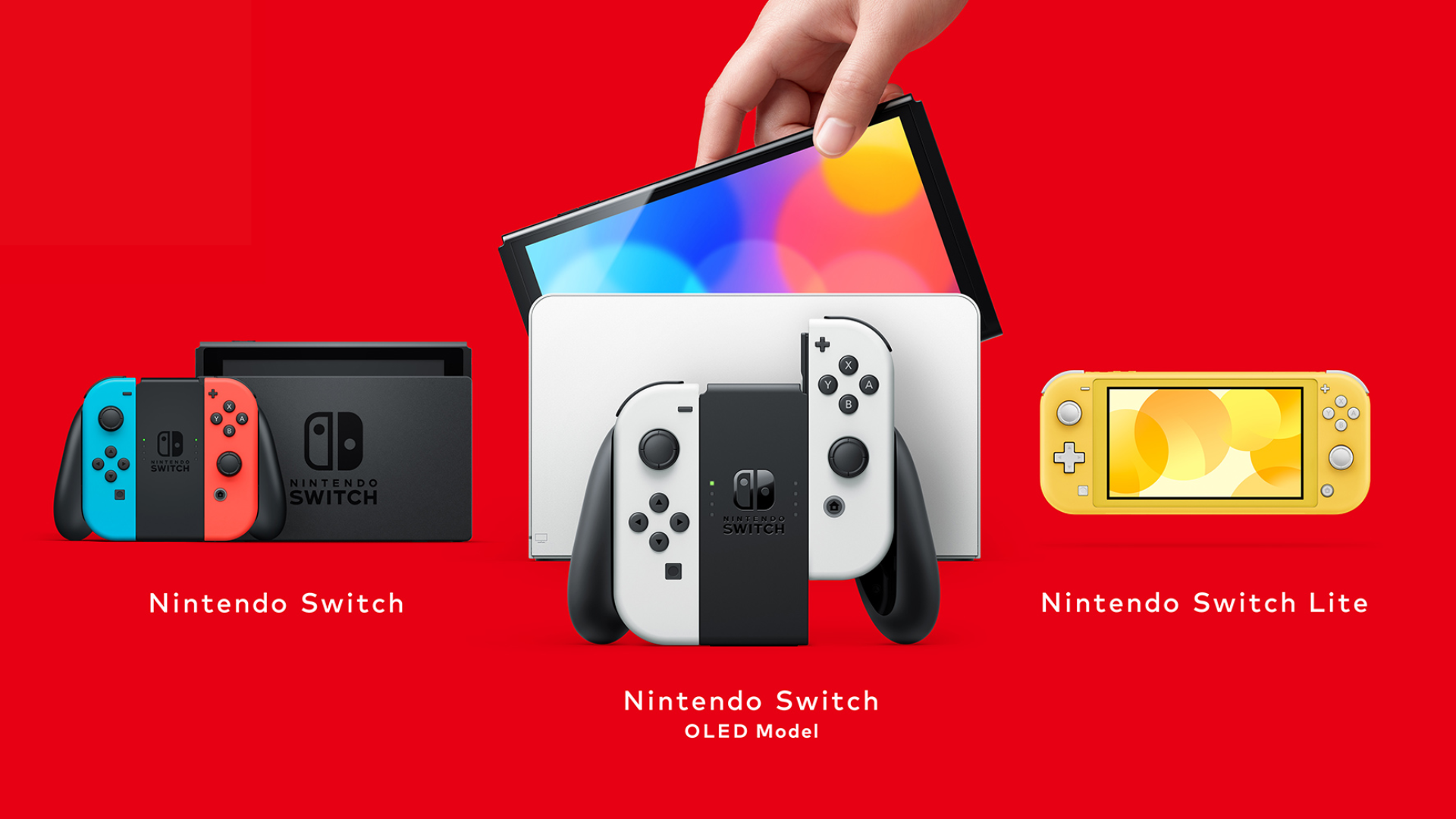The Super Nintendo is one of the most iconic consoles of all time, and understandably so. With a killer line-up of games spanning numerous genres and including some of the highest praised games of the era, there is something for everyone to love. Even 30 years later the system is still seeing support with Retro-Bit’s Wireless Legacy 16 being the latest accessory to grace the legendary console. This new wireless 2.4 GHz input option is looking to delight fans who have grown tired of being tethered to their classic system while also offering support for modern systems.
What’s In The Box
The Legacy 16 comes in a compact box with a near-life-size depiction of the controller on the front. Compatible systems and included receivers are also notated. The side of the box notates a few of the controller’s features while the back of the package gives us a few product shots and further details of the Legacy 16. Opening the box you will find the Legacy 16, wireless receivers for the SNES and USB, USB-C cable, thank you note complete with Retro-Bit social media handles, and a user manual notating usage plus a series of macros to use with the controllers USB mode.
Aesthetics And Build Quality
The Legacy 16 comes in 2 distinct colors: Classic Grey and Onyx, and both look fantastic. When Retro-Bit first revealed the Classic Grey controller I had no expectations for it to turn out well, but oh, how wrong I was! The contrast between the grey and white color schemes is perfect and is my favorite of the 2 colors. The Legacy 16 comes in at roughly the same size as Nintendo’s official SNES controller with a near-identical layout. Start and Select have been leveled out but the D-pad and face buttons should feel familiar to all long-time players of the system. ABXY even features the traditional North American concave and convex button designs!
The biggest departure from the original Super Nintendo controller the Legacy 16 takes is the addition of two analog thumbsticks, home and screenshot buttons, and an extra set of shoulder buttons. Oh, and being wireless of course! I am enjoying the feel of the face buttons, as they feel more responsive than the squishy buttons found on my 30-year-old controller. Each of the 4 shoulder buttons has a good actuation to them, making them pleasing to use. The D-pad leans a bit to the stiff side but shouldn’t be deal-breaking; more on this in a bit.
For the new Analog Sticks Retro-Bit has opted to use Joy-Con type sticks instead of full-sized sticks. This choice allows the button placement to mirror an original SNES pad and keep the back of the controller flat. The sticks have good resistance to them and feel better than those found on the Joy-Con. They are pretty close together, but even with my larger hands, my fingers don’t bump together during gameplay, so it shouldn’t be a big deal for most. Again I will touch on these more in a moment. Rounding out the Legacy 16’s aesthetics is an LED strip and USB-C port.
The build quality of the Legacy 16 is quite good and can withstand a fair amount of punishment. My normal assortment of tests proved little trouble for it! As for the SNES receiver, it is about twice the size of the original controller’s connector and features a sync button, LED indicator, and USB port for future updates. Thanks to its lightweight design I have no fears of it causing any sagging to the Super Nintendo’s controller ports.
Gameplay
While the legacy 16 can be used for any number of devices, my main use case for it is going to be for playing games on my Super Nintendo. I have been using an assortment of wireless options for the SNES for the last few years but this is the first time I have graced my console with a 2.4 GHz option. While input latency on my Bluetooth options hasn’t been very noticeable to me, I know it has affected a number of people out there, so the Legacy 16 using 2.4 GHz is sure to delight. Loading into Mega Man X2 I was greeted with a very responsive gaming session and I couldn’t help but smile at the performance. Each button press registers on the screen as expected and after nearly a month of testing, I have yet to encounter any dropped inputs across my SNES library.
I have to admit that the placement of the D-pad and face buttons being practically identical to an official controller pleases me far more than it really should. After decades of using the SNES, it’s nice to pick up a replacement controller and have it just fit the mold so well for what my fingers expect. Will this matter to anyone else as much as it does to me? Probably not, but that’s alright! Of course, the double shoulder buttons are an area of difference for my muscle memory. Thankfully Retro-Bit has elected to have each button register the input for its corresponding side rather than forcing you into using one or the other. I have frequently found myself swapping between them depending on the game. I’m not quite sure why this is the case, but I find it fascinating.
Now for the D-pad. As I mentioned earlier it does come a bit too close to the stiff side, like the classic GBA D-pad, and I had some concerns about it until I began playing games. Every direction has registered excellently and there is a bit more of a tactile feel as you use it which I truly enjoy. While I am not the greatest Street Fighter player in the world I can easily pull off all of Ryu’s moves on demand, so in the end, it leaves me with few concerns, and changing back to my original SNES controller has me missing the feel of the Legacy 16’s D-pad.
There is another cool feature I want to make mention of when it comes to the D-pad: the left analog stick mirrors its input on SNES systems! While the D-pad was the defacto input method back in the day, playing flight and racing games with it hasn’t been my favorite thing to go back to. With the analog stick, playing Super Mario Kart or Star Fox feels so much better! While the input is still purely digital, it just feels right to experience these games like this. While I don’t have the largest SNES library, I would like to note that I haven’t personally come across any compatibility issues with the Legacy 16. If you happen to come across one let us know in the comments below because I am honestly curious if there will be any!
As mentioned earlier, the Legacy 16 can have a very wide use case with its included USB receiver including Switch, PC, and Android gaming. On the Nintendo Switch, the Legacy 16 is detected as a Switch Pro controller, giving it the same compatibility in games. One exception to this will be mandatory motion control segments found in some Switch titles. Otherwise, this is a great input option for an overwhelming majority of the Switch’s library of games if you want that classic controller feel. The Switch Online SNES library of games also beg to be played with a SNES-styled controller! Just as a note, the Legacy 16 also fully supports the Switch’s built-in controller mapping software so you can fine-tune it to meet your needs on any title.
Thanks to the Legacy 16’s traditional modern layout, it can be used on any PC game you choose that supports controllers, or with SNES emulation for a more authentic experience. One thing to note is that, by default, the Legacy 16 uses a traditional Nintendo button layout. If you are used to Xbox or PlayStation layouts you will need to use one of the controller’s included macros to shift the ABXY buttons into the more familiar layout. The controller also has support for both Xinput and Direct Input, giving the controller compatibility with legacy operating systems for the ultimate retro-themed play.
As for the Legacy 16’s use on mobile devices, I have found myself using the controller mostly for Xbox Cloud Gaming. The lower latency is definitely an improvement over Bluetooth controllers, but internet speeds are always going to be a factor. Still, I have really enjoyed using the controller for this, but do make sure to use that face button macro, otherwise you will be 10 shades of screwed up with your inputs! I also don’t know if there are any phone clips that will support the Legacy 16 out there, so that might make this experience a bit harder while on the move.
Battery life for the Legacy 16 is fantastic, with the controller turning in over 15 hours of play per charge. With the included USB-C cable it is very easy to get the controller charged while not in use. Charging does take a couple of hours, but thankfully the controller remains usable for play while charging if desired.
What It Could Have Done Better
As a Super Nintendo controller, I have no issues to speak of when it comes to using the Legacy 16 and think it’s an excellent cost-effective wireless input device. But as we start to dive into using it on USB-equipped systems, a few shortcomings start to creep into the picture. The severity of these will definitely be dependant on your own preferences but here we go. First off is the controller’s lack of rumble. I have been a huge fan of rumble since the N64 and playing games without it feels a bit odd to me, and kind of takes me out of the experience. The lack of motion controls also makes it so the Legacy 16 can’t be an all-in-one Switch replacement controller for those looking for something to fill that role. NFC support is also missing, but this isn’t as big of a deal compared to the motion controls.
My biggest knock with the Legacy 16 though comes down to the analog thumbsticks and their performance in certain genres of games. For the most part, they handle great and I have had an enjoyable time using them. But, loading into shooters, you can tell they just aren’t meant to be used for them. Aiming can be difficult and the smaller cap sizes make precise aiming more difficult. The classic controller design also makes it hard for me, personally, to play shooters but this isn’t a problem exclusive to the Legacy 16, as I have had the same issues on a number of similarly built devices. Again these things might not bug you as much as they do me, but keep them in mind if you are looking for a controller to fit those purposes.
Verdict
As a Super Nintendo controller, the Legacy 16 is practically perfect for my needs; a fantastic, low-latency way to experience the system wirelessly with a number of fun extras, like using an analog stick for flight and racing games! While it can also be used as a multipurpose controller there are a few things to be aware of depending on the system and genre you hope to use it on. Even still, there is tons of use to be had in the Legacy 16’s solid design, and it’s a controller I can easily recommend to Super Nintendo fans!





























